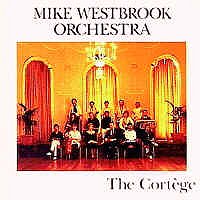|
Not for nothing is jazz called an art of performance. Even the most elaborate jazz compositions evolve through being played, adjusting to the realities of what works best, gaining a new dimension from the exertions of the soloists, moving towards maturity rather than suddenly attaining it. All the finest jazz composers - Ellington, Mingus, Gil Evans, just to pick on three - have worked empirically, learning from how their music sounded on the night, Mike Westbrook belongs within that tradition. And none of his compositions exemplifies it more than The Cortege
At its first performance - at the Bracknell Jazz Festival in the summer of 1979 - The Cortège was considerably shorter than the composition now being toured on the Contemporary Music Network. The order of the pieces was different too, concluding with Phil Minton singing Jerusalem. But that was changed, and other alterations and additions took place as a result of performances at the Edinburgh Festival and in various European cities. Nevertheless, the work seemed to have achieved a definitive form when it was heard at the Roundhouse, London in October, 1980 and broadcast on Radio Three shortly afterwards.
Yet during the 15 months since The Cortège was last performed in public, Mike Westbrook has been reconsidering it. Anybody familiar with
|
those earlier performances will notice the inclusion of three new sectons: Erme Estuary (dedicated to Westbrook’s father, who died in February, 1981), Kyrie and A Hearth Burns. These additions have not been made just for the sake of featuring a soloist or developing a bright new idea, both perfectly honourable reasons under normal circumstances, but because Mike Westbrook believes they help to define more clearly the overall shape of the composition, its structure more tightly integrated - and certainly far more ambitious in scope - than any of his earlier works, as well as emphasizing the underlying theme, mixing the sacred with the profane, juxtaposing solemnity and high jinks.
It is apt that this tour should lake place during the month which sees the celebration of James Joyce’s centenary. Not because Joyce’s literary techniques and Westbrook’s composing methods have very much in common, but because Joyce built his final, larger than art book around that elemental ritual, the Irish wake. Its combining of the tragic and the comic, the trivial and the cosmological, has a lot to do with what lies behind and within The Cortège. The music is not programmatic. No logical connections can be made between the various songs and sequences. Nevertheless, the work expresses more than the sum of its several episodes. And it is, in any case, the first part of what will ultimately be a trilogy
Metaphors can either obscure or clarify - and this is true for the artist as well as his audience.
|
When Mike Westbook chose "The Cortège" as his title he knew he would be writing a piece that mirrored - partly in words, partly in music - what might be styled a trilogy or trinity of themes, Life, Death and Life after Death. He could, he realised, draw upon one of the earliest of jazz traditions, the funeral music of New Orleans (the bands played the dirge, Flee As A Bird, on the way to the burying ground, the ribald Didn’t He Ramble on the way back). But in suggesting a procession The Cortege also implied a context, seen by Westbook as a wall against which that procession moves, a wall that is changed by history. a surface for the slogan and statement of the moment.
Graffiti is the title applied to the closing section. yet that concept permeates the whole of the composition, reflecting the variousness of life. The songs and poems were selected by Westbrook and his wife, Kate, the majority of them in languages other than English, yet all European, simply because that is the culture - the Afro-American one always excepted - of which Westbrook has first-hand experience and understanding. The moods range from the solemn to the outrageous, the stance is sometimes ironic, sometimes boldly emotional, but those extremes should surprise nobody with any experience of the paradoxical process of being alive.
Charles Fox
|
